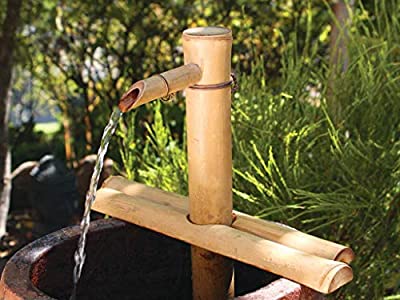Water fountains are a central part of Japanese culture. There are two types of Japanese fountains, Shishi-Odoshi Fountain and Tsukubai Fountain. Both fountains are rich in cultural history.
Tsukubai Fountains
Tsukubai, a Japanese term that means “To squat/crouch” in English. A Tsukubai fountain, is usually located outside of Buddhist temples or Japanese tea gardens. To enter the temple, visitors must “squat” or “crouch”, and then go through the cleansing ritual. Conceptually, this cleansing ritual is very similar to the Christian church’s ablutions ritual. The Tsukubai cleansing ritual includes hand washing and mouth rinses. This cleansing ritual takes place before entering Buddhist temples for tea ceremonies.
Tsukubai fountains are usually made from stone basins, also known as chozubachi. Their most distinctive element is the bamboo pipe, also known as kakei. The basin is finished by a small bamboo scoop that can be placed on top. This spoon can then be used to cleanse the body. Tsukubai fountains can also be found in Japanese-themed homes or outside Japanese tea gardens.
To provide light for the evening tea ceremonies, a stone lantern (also known as ishidoro) is placed next to the tsukubai. When designing the Tsukubai, it is crucial to arrange stones in a way that is pleasing to the eye. The area around Tsukubai is enhanced by green floras, bamboo plants and other plants.
The simple design of the Tsukubai can be a beautiful addition to any garden or tea-house. It will increase its Zen-appeal as well as add cultural history to interest your guests and visitors.
Shishi Odoshi Fountains
 Shishi Odoshi, another Japanese fountain style, is well-known for its unique style and beautiful antique beauty. Shishi Odoshi literally means Deer-Scarer. Japanese farmers used the Shishi-odoshi fountain as a way to repel pests and deer from their fields.
Shishi Odoshi, another Japanese fountain style, is well-known for its unique style and beautiful antique beauty. Shishi Odoshi literally means Deer-Scarer. Japanese farmers used the Shishi-odoshi fountain as a way to repel pests and deer from their fields.
They became more popular as a meditation elements in Japanese culture. Zen Monks find its ability to bring calm serenity to its surroundings very appealing. Shishi-Odoshi is known for its rocking bamboo motion and “clacking” sound. As water is filled from the spout, the bamboo rocked back and forth. The bamboo spout makes a soft, refreshing “clacking” sound when it touches the basin’s surface. This soft sound is especially popular with meditation practitioners. It helps them focus and concentrate.
Because of its beauty and cultural history, shishi odoshi is a Japanese bamboo water fountain that has been cherished for many years.

